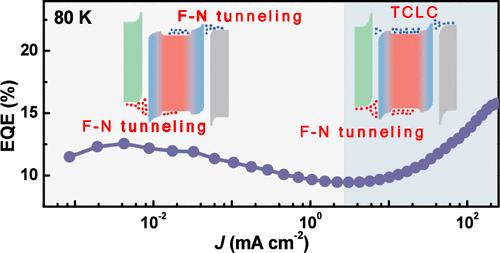当前位置:
X-MOL 学术
›
J. Phys. Chem. Lett.
›
论文详情
Our official English website, www.x-mol.net, welcomes your
feedback! (Note: you will need to create a separate account there.)
Diagnosing the Charge Dynamic Behaviors in Quantum-Dot Light-Emitting Diodes by Temperature-Dependent Measurements
The Journal of Physical Chemistry Letters ( IF 4.8 ) Pub Date : 2024-11-20 , DOI: 10.1021/acs.jpclett.4c02868 Jialin Bai, Xing Liu, Xiaochun Chi, Aiwei Tang, Hanzhuang Zhang, Wenyu Ji
The Journal of Physical Chemistry Letters ( IF 4.8 ) Pub Date : 2024-11-20 , DOI: 10.1021/acs.jpclett.4c02868 Jialin Bai, Xing Liu, Xiaochun Chi, Aiwei Tang, Hanzhuang Zhang, Wenyu Ji

|
Distinguishing and understanding the nonradiative recombination of charges are crucial for optimizing quantum-dot light-emitting diodes (QLEDs). Auger recombination (AR), a well-known nonradiative process, is widely recognized to occur in QLEDs. However, it has not yet been directly observed in a real working QLED. Here, the AR effect is verified in the QLED at temperatures of <150 K. At low temperatures, the QLED exhibits a unique S-shaped external quantum efficiency (EQE) evolution as the driving current density increases. Experimental and modeling results indicate that this S-shaped EQE results from the asynchronous changes in the behavior of injection of electrons and holes into the quantum-dot emission layer. At low driving voltages, both electron and hole currents are limited by the Fowler–Nordheim (F–N) tunneling behavior. The relatively low barrier for electrons leads to overwhelming electron injection and seriously imbalanced charges in the quantum dots, triggering the AR process. As the voltage increases, the electron current within the emission layer is no longer governed by F–N tunneling but limited by space charges. Then, charge injection becomes balanced, and the EQE increases. These results offer valuable insights into the charge injection and recombination processes within QLEDs, as well as implications for device design.
中文翻译:

通过温度相关测量诊断量子点发光二极管中的电荷动态行为
区分和了解电荷的非辐射复合对于优化量子点发光二极管 (QLED) 至关重要。俄歇复合 (AR) 是一种众所周知的非辐射过程,被广泛认为发生在 QLED 中。但是,它还没有在实际工作的 QLED 中直接观察到。在这里,在 <150 K 的温度下在 QLED 中验证了 AR 效应。在低温下,随着驱动电流密度的增加,QLED 表现出独特的 S 形外部量子效率 (EQE) 演变。实验和建模结果表明,这种 S 形 EQE 是电子和空穴注入量子点发射层的行为异步变化的结果。在低驱动电压下,电子电流和空穴电流都受到 Fowler-Nordheim (F–N) 隧穿行为的限制。电子的相对低势垒导致压倒性的电子注入和量子点中严重不平衡的电荷,从而触发 AR 过程。随着电压的增加,发射层内的电子电流不再受 F-N 隧穿的约束,而是受空间电荷的限制。然后,电荷注入变得平衡,EQE 增加。这些结果为 QLED 中的电荷注入和复合过程提供了有价值的见解,并对器件设计产生了影响。
更新日期:2024-11-20
中文翻译:

通过温度相关测量诊断量子点发光二极管中的电荷动态行为
区分和了解电荷的非辐射复合对于优化量子点发光二极管 (QLED) 至关重要。俄歇复合 (AR) 是一种众所周知的非辐射过程,被广泛认为发生在 QLED 中。但是,它还没有在实际工作的 QLED 中直接观察到。在这里,在 <150 K 的温度下在 QLED 中验证了 AR 效应。在低温下,随着驱动电流密度的增加,QLED 表现出独特的 S 形外部量子效率 (EQE) 演变。实验和建模结果表明,这种 S 形 EQE 是电子和空穴注入量子点发射层的行为异步变化的结果。在低驱动电压下,电子电流和空穴电流都受到 Fowler-Nordheim (F–N) 隧穿行为的限制。电子的相对低势垒导致压倒性的电子注入和量子点中严重不平衡的电荷,从而触发 AR 过程。随着电压的增加,发射层内的电子电流不再受 F-N 隧穿的约束,而是受空间电荷的限制。然后,电荷注入变得平衡,EQE 增加。这些结果为 QLED 中的电荷注入和复合过程提供了有价值的见解,并对器件设计产生了影响。


















































 京公网安备 11010802027423号
京公网安备 11010802027423号